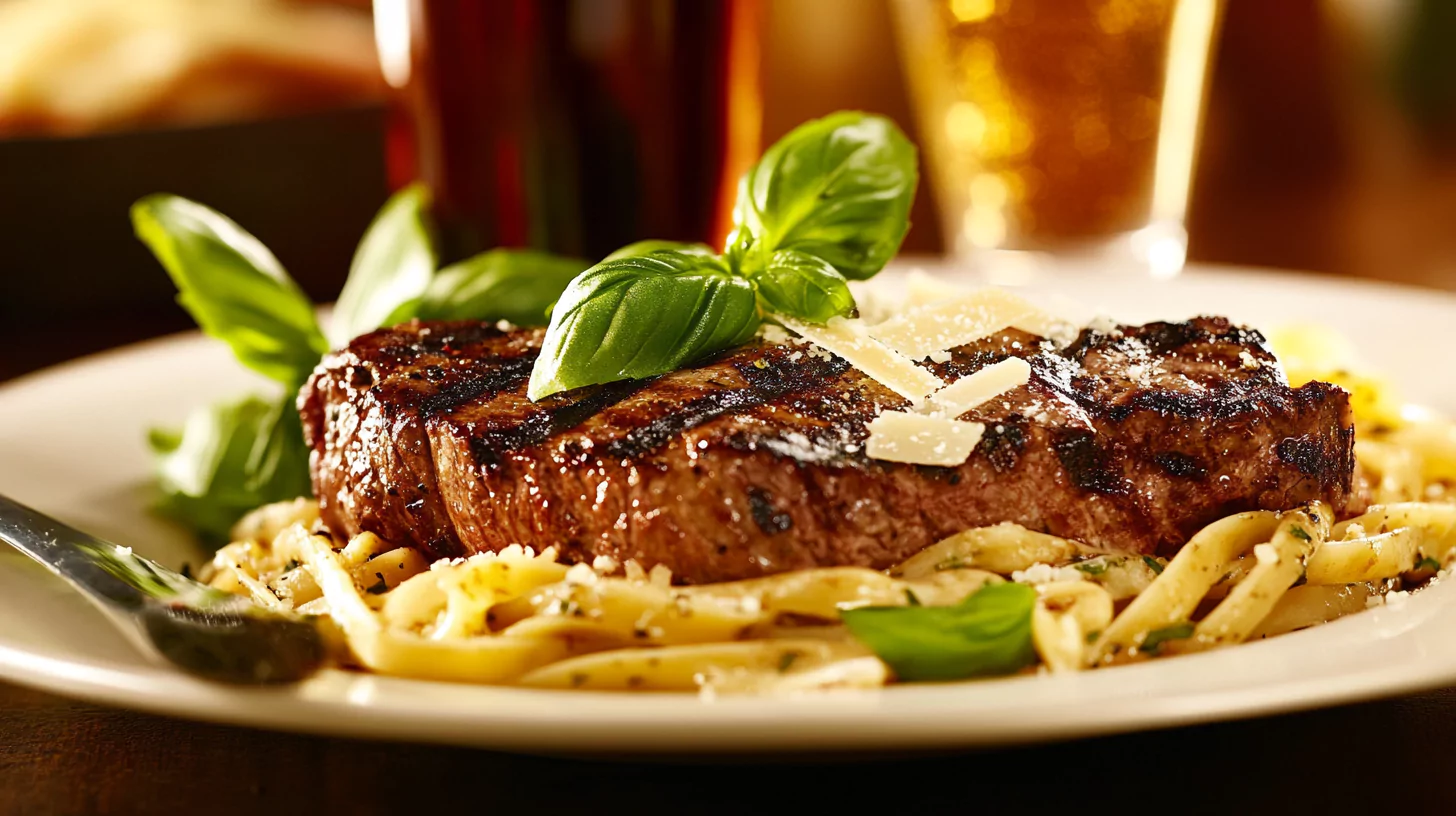When it comes to indulgent meals, steak and pasta are two of the most beloved choices for food enthusiasts. Steak, with its rich, savory flavor and tender texture, has long been a hallmark of hearty dining. Pasta, on the other hand, offers a versatile and comforting base that can adapt to countless sauces, seasonings, and pairings.
But do these two culinary icons truly belong together on the same plate? For many, the combination might seem unconventional, but in reality, steak and pasta often form a harmonious duo. From Italian-inspired classics to creative modern dishes, the pairing opens up a world of possibilities.
This article delves deep into the synergy between these two culinary classics, exploring how their flavors and textures complement each other. We’ll uncover the secrets to creating the perfect pairing, share tips on choosing the right combinations, and provide insight into why this pairing has captured the hearts of food lovers around the world.
The Basics of Steak
Steak is a culinary favorite known for its bold flavors, juicy texture, and endless versatility. It’s derived from premium cuts of beef and comes in a variety of options that can cater to different tastes and preferences. Understanding what makes steak such a remarkable ingredient helps us see why it pairs so well with pasta.
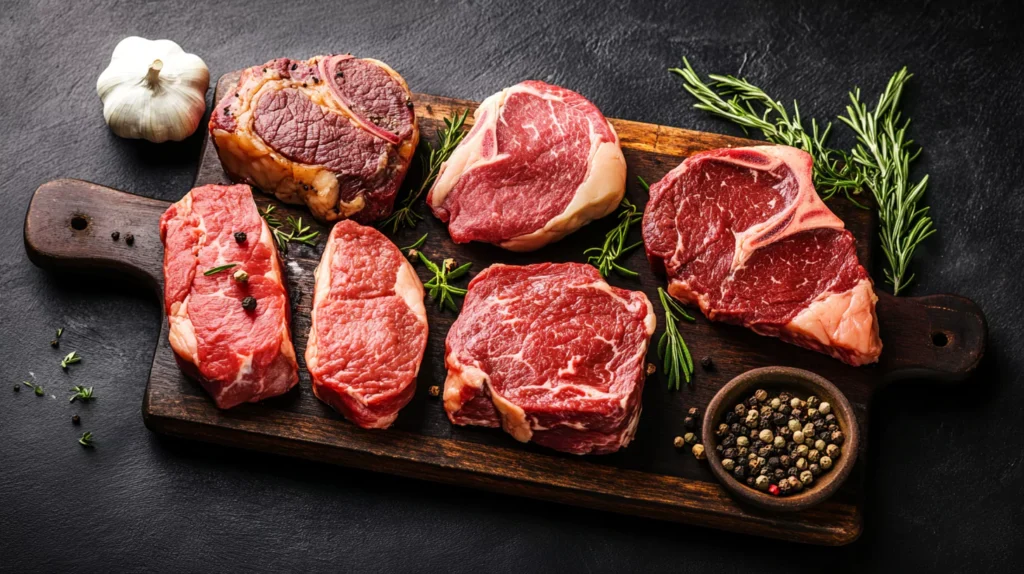
Popular Cuts of Steak
The cut of steak can significantly influence the texture, flavor, and cooking method. Some of the most popular cuts include:
- Ribeye: Known for its rich marbling, ribeye delivers exceptional juiciness and flavor.
- Filet Mignon: A tender, lean cut prized for its melt-in-your-mouth texture.
- New York Strip: Balancing tenderness and beefy flavor, this cut is a crowd favorite.
- Sirloin: A versatile and budget-friendly option that’s great for grilling.
- Flank and Skirt Steak: Known for their bold flavors and perfect for slicing thinly over pasta.
Each of these cuts has unique qualities that can be enhanced with the right preparation and pairings.
Cooking Methods for Steak
The way a meat is cooked can significantly affect its flavor and suitability for pairing with pasta. Some common methods include:
- Grilling: Adds a smoky, charred flavor to the steak, making it a great contrast to creamy or tomato-based pasta sauces.
- Pan-Seared: Creates a crispy crust while locking in juices, ideal for pairing with buttery or garlicky pasta.
- Sous Vide: Ensures even cooking and tenderness, especially when paired with delicate pasta dishes.
- Broiled or Roasted: Enhances the natural flavors of the meat, complementing robust pasta sauces.
The versatility of steak preparation allows chefs to tailor the dish to different pasta pairings.
Why Steak is So Versatile
Steak’s rich, umami flavor profile makes it an excellent match for a wide variety of ingredients. Whether seasoned simply with salt and pepper or marinated with complex spices, Steak’s adaptability shines in many dishes. Its hearty nature and satisfying bite create a wonderful contrast to the soft texture of noodles or other accompaniments.
The World of Pasta
Pasta, a timeless staple in global cuisine, is beloved for its adaptability and comforting appeal. Whether served with simple olive oil and garlic or a complex, multi-layered sauce, Pasta’s versatility makes it an excellent partner for a range of proteins, including beef.
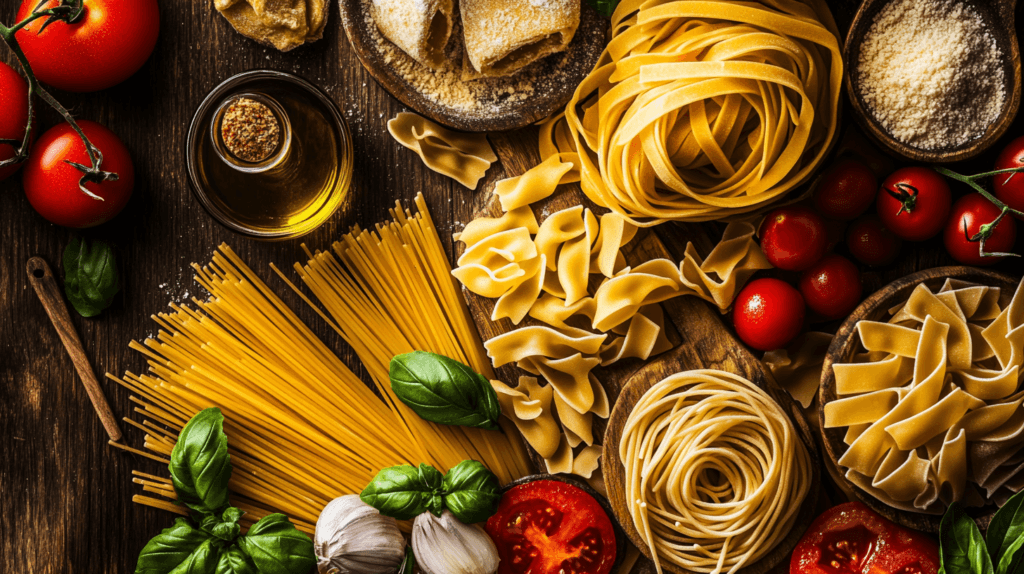
Types of Pasta
Pasta comes in countless shapes and sizes, each offering a unique texture and ability to hold sauces. Some common varieties include:
- Spaghetti: Long and thin, ideal for lighter sauces that coat evenly, such as garlic butter or marinara.
- Fettuccine: A broader, flat pasta that pairs wonderfully with creamy sauces like Alfredo, especially when combined with steak strips.
- Penne: Tube-shaped pasta that captures chunky sauces, perfect for hearty combinations like steak and tomato-based sauces.
- Tagliatelle: Similar to fettuccine but slightly narrower, tagliatelle excels with rich meat sauces, making it an ideal companion for steak.
- Rigatoni: Larger tubes with ridges that trap sauce and meat, ideal for baked pasta dishes with steak as a filling.
- Orzo: A small, rice-shaped pasta often used in salads or broths but can also serve as a bed for steak slices.
The choice of pasta directly influences the flavor and texture balance when paired with a protein like steak.
Sauces that Complement Pasta
The sauce is what elevates pasta from a simple dish to a flavorful experience. When combining pasta with steak, the sauce plays a crucial role in uniting the two elements. Common sauces include:
- Tomato-Based Sauces: Marinara or arrabbiata bring acidity and brightness that cut through the richness of steak.
- Creamy Sauces: Alfredo, carbonara, or cheese-based sauces enhance the dish’s richness, blending beautifully with steak.
- Butter and Herb Sauces: Light and aromatic, these sauces highlight the steak’s natural flavors without overpowering it.
- Pesto: A vibrant, herbaceous sauce that provides a fresh contrast to the heartiness of steak.
- Wine-Based Sauces: Red or white wine reductions add depth to the dish, especially when complemented with steak drippings.
The Adaptability of Pasta
One of pasta’s greatest strengths is its ability to adapt to various cuisines and ingredients. Whether it’s tossed with a classic Italian sauce or part of a fusion recipe, Pasta pairs seamlessly with diverse flavors and textures. This adaptability makes it a natural match for rich protein options, like beef prepared in countless ways.
Why Steak and Pasta Work Together
Pairing steak and pasta might seem unconventional to some, but it’s a match made in culinary heaven. The combination of rich, savory steak and the soft, comforting texture of pasta creates a dynamic contrast that pleases the palate. Here’s why this pairing works so well:
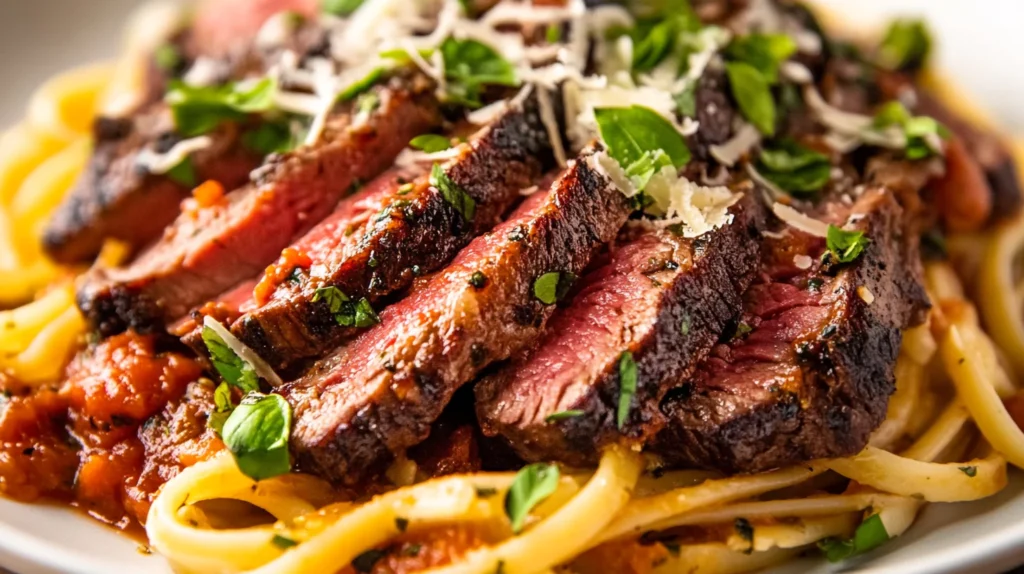
The Science of Complementary Flavors
At the heart of any great pairing lies the interplay of flavors. Steak and pasta excel together due to their contrasting and complementary profiles:
- Richness Meets Neutrality: Steak is rich and flavorful, often seasoned with bold spices or marinades. Pasta, by contrast, is neutral and absorbs flavors from accompanying sauces. This balance ensures no single element overpowers the dish.
- Umami Boost: Steak and pasta both contain umami elements, especially when paired with ingredients like parmesan cheese, mushrooms, or tomato-based sauces. This deepens the dish’s overall flavor profile.
- Textural Balance: The tender, juicy texture of steak contrasts beautifully with the soft, chewy bite of pasta. When combined, they offer a satisfying mouthfeel with every bite.
How Sauces Unite Steak and Pasta
The secret to a great steak-and-pasta dish often lies in the sauce. Whether creamy, tangy, or buttery, the right sauce bridges the gap between the two components. For example:
- Tomato-Based Sauces: These provide acidity and sweetness that cut through the steak’s richness, creating a balanced taste.
- Creamy Sauces: Alfredo or béchamel offer a luxurious feel that coats both the steak and pasta, tying them together seamlessly.
- Herb-Infused Butter Sauces: Light, aromatic sauces made with fresh herbs and garlic enhance the flavors of steak without overshadowing the pasta.
The Role of Seasoning and Ingredients
Careful seasoning and ingredient selection elevate the pairing. Adding garlic, rosemary, or thyme to a steak can create an aromatic complement to herbaceous pasta sauces. Similarly, ingredients like parmesan, capers, or sun-dried tomatoes can add bursts of flavor to the overall dish.
A Global Perspective
Cultures worldwide showcase their take on steak and pasta:
- Italian Influence: Tagliatelle with a beef ragù or bistecca alla Fiorentina served with pasta sides highlights the synergy between the two.
- American Fusion: Creamy steak pasta dishes with a Cajun or garlic butter twist are popular in modern cuisine.
- Asian Inspiration: Fusion recipes like teriyaki beef with udon noodles or soy-glazed steak with soba showcase the versatility of combining steak with pasta-like bases.
A Match for Every Occasion
Whether you’re preparing a simple weeknight dinner or a luxurious meal for a special occasion, steak and pasta provide endless possibilities. Their ability to adapt to various sauces, ingredients, and cooking styles ensures there’s a combination for every palate.
Popular Steak and Pasta Pairings
This combination has evolved into a variety of beloved dishes that cater to diverse palates and cuisines. From Italian classics to creative fusion recipes, these combinations highlight the versatility and appeal of this duo. Let’s explore some of the most popular steak and pasta pairings.
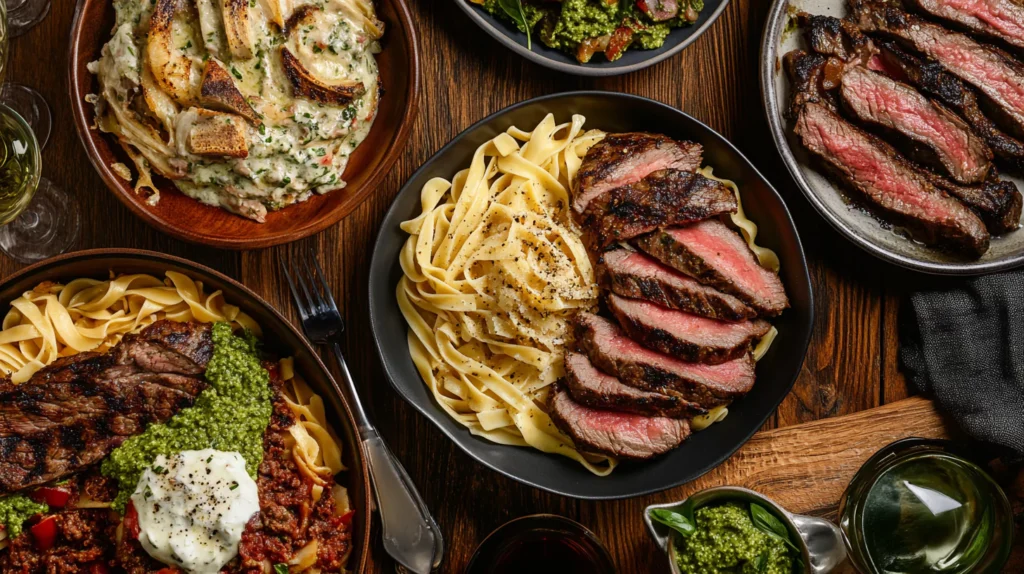
1. Tagliatelle with Beef Ragù
A timeless Italian dish, tagliatelle with beef ragù combines wide, flat pasta with a rich, slow-cooked sauce made from ground or shredded beef, tomatoes, wine, and aromatic herbs. The flavors are hearty and satisfying, with the steak providing a robust depth to the dish.
2. Steak Alfredo
This creamy, indulgent dish pairs tender slices of grilled steak with fettuccine Alfredo. The cream-based sauce, made with butter, heavy cream, and parmesan cheese, complements the savory richness of the steak, creating a luxurious meal.
3. Spaghetti with Garlic Butter Steak Bites
For a simple yet flavorful option, bite-sized pieces of pan-seared steak are tossed with spaghetti in a garlic butter sauce. The simplicity of the preparation highlights the natural flavors of the steak, while the garlic butter adds richness.
4. Penne with Steak and Pesto
Penne pasta coated in a vibrant pesto sauce serves as the perfect backdrop for grilled steak strips. The herby, nutty flavors of the pesto contrast beautifully with the savory beef, resulting in a fresh and satisfying dish.
5. Steak Stroganoff
Inspired by the classic Russian dish, this variation combines tender steak strips with pasta, typically egg noodles, in a creamy sauce flavored with mushrooms, onions, and sour cream. It’s a comforting and hearty meal perfect for cold evenings.
6. Cajun Steak Pasta
A bold and spicy option, Cajun steak pasta features penne or fettuccine coated in a creamy, seasoned sauce infused with Cajun spices. Slices of blackened steak add a smoky flavor that pairs well with the creaminess of the dish.
7. Baked Rigatoni with Steak
For those who love baked pasta, this dish layers rigatoni with tomato sauce, mozzarella, and steak chunks before baking it to perfection. The result is a cheesy, comforting casserole with a rich meatiness.
8. Asian-Inspired Fusion Dishes
Steak and pasta combinations also appear in fusion cuisine, such as:
- Soy-Glazed Steak with Soba Noodles: Thinly sliced steak glazed with soy-based sauce served over buckwheat noodles.
- Teriyaki Steak Udon: A Japanese-inspired dish featuring thick udon noodles tossed with teriyaki-flavored steak and vegetables.
9. Surf and Turf Pasta
For a luxurious twist, surf and turf pasta combines steak with seafood (like shrimp or lobster) in a creamy or tomato-based sauce. This pairing offers a mix of land and sea flavors for a truly decadent meal.
Each of these dishes demonstrates the versatility of steak and pasta as a pairing, showing how different sauces, ingredients, and cooking methods can elevate the combination.
Choosing the Right Pasta for Steak
The magic of steak and pasta lies not only in the flavors but also in selecting the perfect pasta to complement the type of steak and sauce. The right combination enhances the overall dining experience, balancing textures and tastes.
Matching Pasta Shapes to Steak Cuts
Different pasta shapes serve various roles in a dish, and when paired with steak, certain shapes shine due to their ability to hold sauces and complement the meat’s texture.
- Long Pasta for Sliced or Stripped Steak
- Examples: Spaghetti, Fettuccine, Tagliatelle
- Why it works: Long pasta provides a smooth base for thinly sliced or seared steak strips. Sauces cling well to these noodles, creating a harmonious bite.
- Tubular Pasta for Chunky Steak Pieces
- Examples: Penne, Rigatoni, Ziti
- Why it works: The hollow shapes of tubular pasta trap sauces and steak juices, ensuring every bite is flavorful. These shapes are ideal for robust, tomato-based, or creamy sauces.
- Flat or Ribbon Pasta for Hearty Steak Sauces
- Examples: Pappardelle, Lasagna Sheets
- Why it works: Wider pasta can hold up to rich, meat-heavy sauces like ragù or stroganoff, allowing the steak to shine.
- Small Pasta for Bite-Sized Steak Pieces
- Examples: Orzo, Ditalini, Farfalle
- Why it works: Smaller pasta works well in soups, salads, or light dishes where steak is cut into small cubes or bites, creating a balanced texture.
Considering Sauce Consistency
The type of sauce can influence the best pasta choice:
- Creamy Sauces: Pair best with flat or tubular pasta to catch the richness. Fettuccine Alfredo with steak is a classic example.
- Chunky Tomato-Based Sauces: Work well with ridged pasta like rigatoni or penne, which can trap the sauce’s hearty ingredients.
- Light Butter or Herb Sauces: Complement long, delicate noodles like spaghetti or angel hair, ensuring the steak remains the star.
Adapting to Cooking Techniques
The way you prepare the steak also impacts pasta choice:
- Grilled Steak: Often has a smoky, charred flavor that pairs nicely with bold, tomato-based pasta like arrabbiata or marinara.
- Pan-Seared Steak: With its crispy crust and juicy interior, it matches beautifully with creamy or garlic butter pasta.
- Braised or Slow-Cooked Steak: Ideal for pairing with pasta that can handle the rich, concentrated flavors of the meat, like pappardelle or gnocchi.
Tailoring to Dietary Preferences
For those seeking healthier or alternative options:
- Whole-Grain Pasta: Adds a nutty flavor and works well with grilled or seared steak.
- Gluten-Free Pasta: Options like rice or chickpea pasta can easily replace traditional pasta in steak dishes without compromising flavor.
- Zucchini Noodles or Veggie Spirals: For a low-carb alternative, these vegetable-based “noodles” pair best with thinly sliced steak and lighter sauces.
Choosing the right pasta for steak isn’t just about aesthetics—it’s about finding a pairing that elevates both components, creating a dish that’s greater than the sum of its parts.
Choosing the Right Sauce
When combining steak and pasta, the sauce plays a pivotal role in unifying the flavors of both components. The right sauce enhances the steak’s richness and elevates the pasta’s role, ensuring a balanced and cohesive dish. Let’s explore how to select the perfect sauce for your steak and pasta pairings.
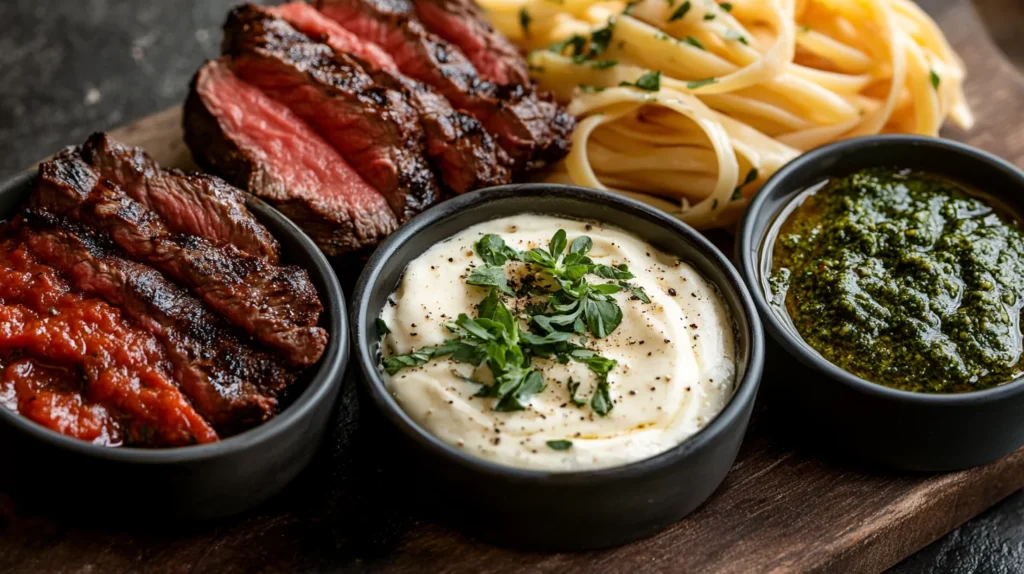
1. Cream-Based Sauces
Rich, creamy sauces are a popular choice for steak and pasta dishes. They add a luxurious texture and flavor that complements the savory depth of steak.
- Alfredo Sauce: Made with butter, cream, and Parmesan cheese, Alfredo sauce pairs beautifully with grilled or pan-seared steak and fettuccine or pappardelle pasta.
- Carbonara: A classic Italian sauce made with egg, cheese, and pancetta, carbonara enhances the flavors of thinly sliced steak when combined with spaghetti or tagliatelle.
- Garlic Cream Sauce: Infused with garlic, this sauce works well with buttery steak bites and penne or rigatoni.
2. Tomato-Based Sauces
Tomato sauces provide acidity and sweetness, balancing the richness of steak and pasta.
- Marinara Sauce: A simple and fresh option that pairs nicely with grilled steak and spaghetti or rigatoni.
- Arrabbiata Sauce: For those who enjoy a bit of heat, this spicy tomato sauce complements charred or blackened steak cuts.
- Bolognese Sauce: A meat-based tomato sauce, Bolognese is perfect for combining ground steak with pasta like tagliatelle or lasagna.
3. Butter and Herb Sauces
Light and aromatic, butter-based sauces let the steak’s natural flavors shine while adding a silky texture to the pasta.
- Garlic Butter Sauce: Simple yet flavorful, it enhances the steak’s seared crust and works well with spaghetti or linguine.
- Lemon Butter Sauce: A zesty variation that pairs beautifully with steak and fresh pasta like tagliatelle or angel hair.
- Herb-Infused Butter: Combining butter with rosemary, thyme, or parsley creates a fragrant sauce that complements grilled steak and lighter pasta.
4. Wine-Based Sauces
Wine reductions add depth and sophistication to steak and pasta dishes, with flavors ranging from tangy to earthy.
- Red Wine Reduction: A bold sauce that complements steaks with a rich, hearty flavor, ideal for pairing with wide pasta like pappardelle.
- White Wine Sauce: A lighter option that pairs well with creamy or herb-infused pasta, enhancing the flavor of seared steak.
5. Pesto Sauces
Pesto offers a fresh, herbaceous flavor that contrasts beautifully with the richness of steak.
- Classic Basil Pesto: A vibrant green sauce that pairs well with grilled steak and penne or fusilli.
- Sun-Dried Tomato Pesto: For a tangier twist, this pesto works wonderfully with sirloin steak and rigatoni.
- Kale or Spinach Pesto: A modern take on classic pesto, these variations bring earthiness to steak and pasta dishes.
6. Specialty and Fusion Sauces
For those looking to experiment, fusion sauces offer unique flavors and pairings.
- Teriyaki Glaze: A sweet and savory sauce that complements thinly sliced steak and soba noodles in Asian-inspired dishes.
- Cajun Cream Sauce: Spicy and creamy, this sauce enhances the flavors of blackened steak and pasta like fettuccine.
- Cheese Sauce: A decadent option for pairing with ribeye or sirloin steak in baked pasta dishes like mac and cheese.
Balancing Sauce with Cooking Method
- Grilled steak pairs well with lighter, tangy sauces like tomato-based or herb-infused butter.
- Pan-seared steak benefits from creamy or wine-based sauces that enhance its caramelized crust.
- Braised steak cuts shine with richer, thicker sauces like Bolognese or Alfredo.
Experimentation is Key
Don’t be afraid to experiment with sauce flavors and combinations. Adding ingredients like truffle oil, chili flakes, or fresh basil can transform a simple sauce into something extraordinary.
The sauce you choose can make or break your steak-and-pasta pairing, so consider the flavors and textures of your dish to create the perfect harmony.
Cooking Techniques for Steak and Pasta Together
Achieving the perfect beef-and-pasta pairing requires not only the right ingredients but also mastery over cooking techniques. From timing to seasoning, every step plays a role in ensuring the flavors and textures harmonize. Here’s a guide to crafting an impeccable steak-and-pasta dish.
1. Preparing the Steak
Steak is the centerpiece of the dish, so cooking it to perfection is crucial. The technique you choose can influence the overall flavor and pairing.
- Seasoning the Steak:
- Keep it simple with salt, pepper, and olive oil for a classic approach.
- Add herbs like rosemary, thyme, or garlic for extra aroma and flavor.
- For a bolder taste, marinate the steak in soy sauce, balsamic vinegar, or red wine for 1-2 hours before cooking.
- Cooking Methods:
- Grilling: Perfect for adding a smoky, charred flavor that contrasts beautifully with creamy or tangy pasta sauces.
- Pan-Searing: Creates a flavorful crust that enhances the richness of buttery or garlic-based pasta.
- Sous Vide: Ensures evenly cooked steak with maximum tenderness, ideal for delicate pasta dishes.
- Broiling: Retains juiciness and works well with robust pasta dishes like those with marinara or Bolognese sauces.
- Achieving the Right Doneness:
- Rare: Juicy and tender, ideal for minimalist pasta dishes like spaghetti aglio e olio.
- Medium Rare: A versatile choice that pairs with both creamy and tomato-based sauces.
- Well-Done: Best suited for heavily seasoned or sauced pasta dishes where the steak is diced or shredded.
2. Perfecting the Pasta
The pasta serves as the foundation of the dish, so attention to detail in its preparation is essential.
- Cooking Pasta Al Dente:
- Boil pasta until it’s firm to the bite. This texture holds up better when mixed with steak and sauce.
- Add a generous pinch of salt to the boiling water to enhance the pasta’s flavor.
- Timing is Key:
- Start cooking the pasta when the steak is resting. This ensures both components are ready simultaneously.
- Reserve a cup of pasta water before draining. The starchy water can be used to adjust the sauce’s consistency.
- Tossing with Sauce:
- Always mix the pasta with the sauce over low heat to ensure even coating.
- Add steak drippings or pan juices for an extra layer of flavor.
3. Bringing Steak and Pasta Together
Combining steak and pasta requires careful attention to balance and presentation.
- Slicing the Steak:
- Slice the steak against the grain into thin strips for maximum tenderness.
- For chunkier pasta dishes, dice the steak into bite-sized pieces.
- Layering the Dish:
- For sauced pasta, toss the pasta with the sauce first, then top it with steak slices.
- For lighter dishes, place the steak on a bed of plain or lightly buttered pasta, allowing the meat to shine.
- Garnishing:
- Add grated Parmesan, fresh basil, or a drizzle of olive oil for a professional touch.
- Use cracked black pepper or chili flakes for extra seasoning at the table.
4. Enhancing Flavors During Cooking
- Deglazing the Pan:
After cooking the meat, deglaze the pan with wine, broth, or pasta water to create a quick, flavorful sauce. - Infusing Butter or Oil:
Cook garlic, shallots, or herbs in butter or olive oil to create a base for the sauce. - Combining Ingredients:
Toss the meat and pasta together with the sauce just before serving to ensure the flavors meld beautifully.
5. Tools and Tips for Success
- Use a cast-iron skillet for searing steak, as it retains heat and creates a perfect crust.
- A large, deep pan is ideal for tossing pasta and sauce without spills.
- Always let the steak rest for 5-10 minutes before slicing to retain juices.
By following these techniques, you can ensure that your dish not only tastes incredible but also presents beautifully on the plate.
Health and Nutritional Considerations
While this pairing is undeniably delicious, it can also be quite rich and calorie-dense. However, with thoughtful ingredient choices and preparation techniques, you can create a healthier version of this classic combination without compromising on flavor.
1. Choosing Lean Cuts of Steak
The type of meat you choose significantly impacts the dish’s nutritional profile. Opting for leaner cuts reduces saturated fat and calorie content.
- Best Lean Cuts for Steak and Pasta:
- Sirloin
- Top round
- Eye of round
- Filet mignon (in smaller portions)
- Trimming the Fat:
Remove visible fat before cooking to further lower the fat content.
2. Using Healthier Pasta Options
Traditional pasta is often made from refined wheat, which can be high in carbohydrates. Substituting with healthier alternatives can provide more nutrients and cater to dietary restrictions.
- Whole-Grain Pasta: Contains more fiber, which aids digestion and promotes satiety.
- Legume-Based Pasta: Made from lentils, chickpeas, or black beans, these are high in protein and lower in carbs.
- Zucchini Noodles or Spaghetti Squash: Excellent low-carb options for those seeking lighter meals.
- Gluten-Free Pasta: Suitable for those with gluten intolerance or celiac disease.
3. Lightening Up the Sauce
Rich sauces like Alfredo or Bolognese can add significant calories. Modifying these sauces can make them lighter and healthier.
- Creamy Sauces:
- Substitute heavy cream with Greek yogurt or low-fat milk.
- Use pureed cauliflower or cashews for a creamy texture without the added fat.
- Tomato-Based Sauces:
- Opt for fresh or canned tomatoes with no added sugar.
- Add extra vegetables like zucchini, mushrooms, or spinach for added nutrients.
- Butter-Based Sauces:
- Replace some of the butter with olive oil for heart-healthy fats.
- Incorporate fresh herbs for flavor without additional calories.
4. Balancing Portions
Portion control is key to enjoying steak and pasta while maintaining a balanced diet.
- beef: A serving size of steak should be about 3-4 ounces (roughly the size of a deck of cards).
- Pasta: Stick to a serving size of 1 cup of cooked pasta, which is approximately 200 calories.
- Vegetables: Fill at least half your plate with steamed or roasted vegetables to add volume and fiber to your meal.
5. Cooking with Health in Mind
Adopt healthier cooking methods to reduce unnecessary fats and calories.
- Grilling or Broiling: Requires little to no added fat, enhancing the steak’s natural flavors.
- Sautéing in Olive Oil: A heart-healthy alternative to cooking with butter.
- Boiling Pasta Al Dente: Helps control the glycemic index, preventing spikes in blood sugar.
6. Incorporating Nutrient-Rich Additions
Enhance the nutritional profile of your beef and pasta dish with these healthy additions:
- Leafy Greens: Add spinach, kale, or arugula to your pasta for extra vitamins and minerals.
- Healthy Fats: Sprinkle chopped nuts, avocado slices, or a drizzle of olive oil for added healthy fats.
- Lean Protein: Incorporate grilled shrimp, chicken, or tofu alongside steak for a high-protein meal.
- Low-Sodium Options: Use low-sodium broth and seasonings to manage salt intake.
7. Customizing for Dietary Preferences
Adapt the dish to suit specific dietary needs while maintaining flavor and balance.
- Low-Carb/Keto-Friendly:
- Use spiralized vegetables or shirataki noodles instead of pasta.
- Pair steak with a creamy, keto-friendly Alfredo sauce made from heavy cream and parmesan.
- Vegetarian or Vegan Alternatives:
- Substitute steak with plant-based protein options like seitan or portobello mushrooms.
- Use cashew cream or nutritional yeast for vegan-friendly sauces.
8. Moderation is Key
when enjoyed occasionally and in moderation, can be part of a balanced diet. Focus on mindful eating by savoring each bite and avoiding oversized portions.
FAQs About Steak and Pasta Pairings
To address common questions and concerns about this delicious combination, here are detailed answers to frequently asked questions about this popular pairing.
1. What Sauces Go Best with Steak and Pasta?
The sauce is critical in tying together the flavors of steak and pasta. Here’s a quick guide:
- Creamy Sauces: Alfredo, garlic butter create a rich, indulgent pairing, especially with grilled or pan seared steak.
- Tomato-Based Sauces: Marinara, arrabbiata, or Bolognese bring acidity that complements the savory richness of steak.
- Pesto Sauces: Fresh and herbaceous, pesto pairs well with lighter cuts of steak and pasta like penne or fusilli.
- Wine-Based Sauces: A red wine reduction or white wine butter sauce adds sophistication and depth to the pairing.
2. Can Seafood Pasta Be Paired with Steak?
Yes, combining beef with seafood pasta can create a luxurious surf-and-turf meal. Some tips include:
- Use creamy sauces like Alfredo or butter-garlic, as they complement both the steak and seafood.
- Add grilled shrimp or lobster to steak and pasta dishes for a gourmet twist.
- Avoid overly bold steak marinades that may overpower delicate seafood flavors.
3. How Can I Make Steak and Pasta Healthier?
To enjoy this pairing guilt free, consider the following:
- Opt for whole grain or legume based pasta for added fiber and protein.
- Choose lean steak cuts like sirloin or top round to reduce fat.
- Use lighter sauce alternatives, such as tomato based sauces or Greek yogurt in place of heavy cream.
- Incorporate vegetables like spinach, mushrooms, or zucchini into the dish for added nutrients.
4. What Type of Pasta Should I Choose for Heavier Steak Cuts?
Heavier steak cuts, like ribeye or T-bone, pair best with pasta that can handle robust flavors. Choose:
- Wide Ribbon Pasta: Pappardelle to hold rich sauces and chunks of steak.
- Tubular Pasta: Penne or rigatoni to capture sauce and steak juices in their hollow centers.
5. Can I Use Leftover Steak in Pasta Dishes?
Absolutely! Leftover beef is perfect for pasta dishes and can save time in the kitchen. Here are a few ideas:
- Slice leftover steak thinly and toss it with spaghetti and garlic butter.
- Dice steak into small pieces and add it to a creamy Alfredo sauce.
- Shred leftover steak and mix it into a hearty tomato-based sauce for a quick ragù.
6. What Are Some Fusion Ideas for Steak and Pasta?
For a unique take on this classic pairing, explore fusion cuisine:
- Asian Influence: Combine thinly sliced teriyaki steak with soba noodles or udon in a soy-based sauce.
- Mexican Twist: Use chipotle-seasoned steak with pasta tossed in a creamy avocado or salsa verde sauce.
- Mediterranean Flair: Pair grilled steak with orzo, olives, feta cheese, and a light lemon-herb dressing.
7. What Mistakes Should I Avoid When Pairing Steak and Pasta?
To ensure a perfect pairing, avoid these common errors:
- Overcooking the beef, which can make it tough and overpower the pasta.
- Choosing a pasta shape that doesn’t match the sauce’s consistency (e.g., thin sauces with large pasta).
- Using overly complex sauces that mask the natural flavors of the steak.
With these answers, you’re well equipped to make the most of steak and pasta pairings, addressing every detail from sauce selection to creative fusion ideas.

